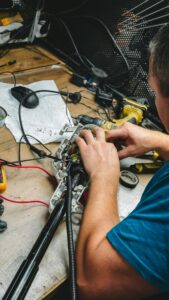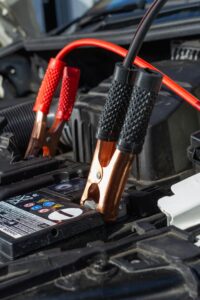If your vehicle just won’t start, or the dashboard lights flicker, more likely than not you’ve got electrical issues on your hands. It means your car is in need of a car electrical repair. Unlike a tire change or an oil top-off, electrical malfunctions aren’t necessarily visible—and that makes them problematic.
On modern vehicles, the electrical system operates everything from starting the engine to rolling down windows. Learning how it functions—and what can go awry—can save you money, time, and grief.
Why Electrical Issues Are On The Rise
Today’s cars are chock full of more technology than ever before. With touch screens, rearview cameras, heated seats, and Bluetooth connectivity, your vehicle is essentially a rolling computer. All of this relies on a delicate network of wiring, sensors, and control modules.
Though these accessories make driving safer and more enjoyable, they also enhance the risk of electrical breakdown. A single faulty wire or bad sensor can wreak havoc on several systems, keeping you wondering.
Universal Signs of Car Electrical Problems
Car electrical troubles don’t necessarily appear with warning lights. Some typical warning signs are
Car won’t start or takes a long time to start
Dim or flashing headlights
Power locks or windows not functioning
Dashboard warning lights acting erratically
Battery draining too fast
If you see any of these, it’s a good idea to check the electrical system or go see a good mechanic.
—
Car Battery: The Heart of the System

Consider the battery as your car’s electrical system backbone. It holds power and delivers the energy required to engage the engine. As the battery starts to fail, you’ll first experience it at start-up. A slow crank, clicking, or nothing at all are all signs that your battery is dying.
Regular battery checks and every 3–5 year replacement can prevent these issues.
—
The Alternator: Charging As You Drive
The alternator charges your battery when you’re on the road. When it fails, the battery discharges rapidly, and your vehicle will cut off during a drive. Some signs of a failing alternator include dashboard warning lights, low-intensity headlights, and malfunctions in the radio and air conditioner.
Getting your alternator checked during routine maintenance can prevent surprise breakdowns.
Fuses and Relays: Small Parts, Big Roles
Fuses and relays control and protect the electrical flow to various car systems. When a fuse blows, that part of your car—like the radio or headlights—may stop working. Replacing a blown fuse is usually simple and inexpensive, but repeated blowouts can signal a deeper issue like a short circuit.
Always use the correct fuse rating to prevent overheating or fire risks.
—
Wiring and Connectors: Easy to Miss, Hard to Diagnose
Wires run through almost every part of your car, connecting batteries, sensors, lights, and switches. Corrosion, heat damage, or rodents can wear out or break wires. These problems can cause random malfunctions or intermittent failures.
Finding wiring issues often requires visual inspection and the use of tools like multimeters or scan tools.
—
Diagnosing Electrical Problems: What You’ll Need
If you’d like to test electrical problems at home, here are some tools that you can use:
Multimeter: Tests voltage, resistance, and current
OBD2 Scanner: Inserts into your car’s port to scan error codes
Test Light: Basic tool for testing power in wires and fuses
Wiring Diagrams: Allows following of where the power should and should not be
These gadgets can save you time and assist in deciding if you can fix it yourself or require a mechanic.
DIY Repairs vs. Professional Assistance
While easy repairs such as replacing a fuse or a battery are within the abilities of many car owners, certain electrical issues need to be delved into by more extensive knowledge. Today’s vehicles employ computerized systems that are sensitive and interconnected.
If your car problems include sensors, ECUs (Engine Control Units), or the CAN bus system, it’s best to let a qualified technician deal with it. They possess the correct tools and knowledge to diagnose and fix without causing further damage.
—
How to Prevent Electrical Problems in Your Car
Preventive maintenance can keep your electrical system in good shape:
Check battery terminals for corrosion
Check wiring periodically for visible wear
Leave electronics off during starting the vehicle
Don’t overload circuits with aftermarket gear
Employ weatherproof covers on connectors exposed to the environment
Preventive checks can be included with your routine oil change or tire rotation interval to get in front of issues.
—
When to Replace vs. Repair
Not all electrical issues demand new components. But at times, repair expenses can approach the cost of replacement. In case your alternator, starter, or ECU has malfunctioned more than once, or your mechanic concludes that there’s a system-wide problem, then replacement is more economical.
Conversely, minor repairs such as repairing a short circuit or replacing a solitary sensor can restore complete operation at an affordable cost.
—
Final Thoughts: Knowledge Is Power
Electric problems in your vehicle may look daunting, but learning the fundamentals makes you the boss. Watch for early signs, spend money on basic diagnosis tools, and keep up with regular maintenance. Whether you are a veteran do-it-yourselfer or one who likes to let a professional take care of it, being aware of how your vehicle’s electrical system operates will assist you in making wiser choices and prevent unforeseen surprises.
